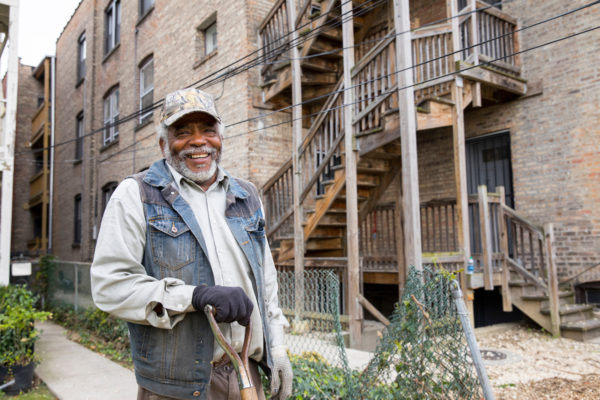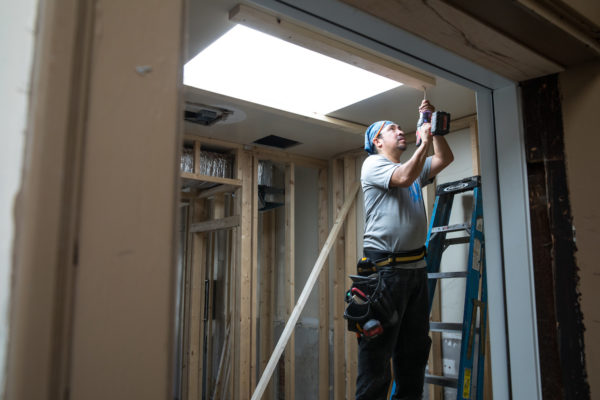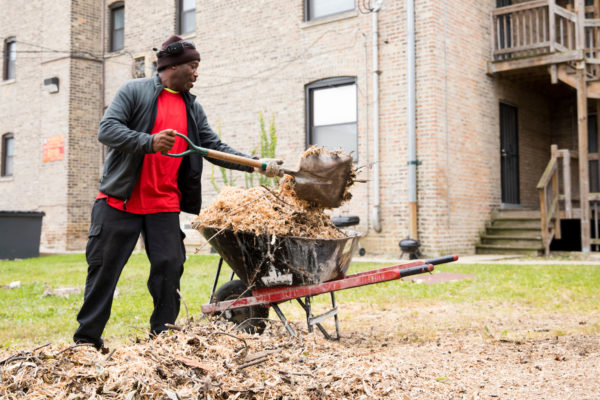NOAH Risk Analysis: What, Where, Who, and When
Preservation Lab Process and Overview
The Preservation Lab is a joint effort of The Preservation Compact and the Institute for Housing Studies at DePaul University (IHS). The mission of the Lab is to investigate challenging and complex affordable rental housing preservation topics by developing research and analysis, engaging stakeholders, and capturing discussion and conclusions in a policy brief. Our first Preservation Lab process and report examined resources to stabilize vulnerable tenants and buildings during the COVID-19 pandemic.
The second Preservation Lab topic focused on the Naturally Occurring Affordable Housing (NOAH) stock in Chicago by examining building types, neighborhood dynamics, ownership, and short- and long-term risk factors. A better understanding of these elements will drive optimal preservation strategies.
Core Group Members

Christine Moran
IHDA

Daniel Hertz
City of Chicago

Ghian Foreman
Emerald South Economic Development Collaborative

Heather Barnes
Communities United

Jon Womack
Third City Properties

Julio Rodriguez
Northwest Side Housing Center

Mike Tomas
Garfield Park Community Council

Rafael Leon
CMHDC

Raul Raymundo
Resurrection Project

Stephen Rich, Jr.
Blue Whale Collective

Steve Thomas
5T Management

Taz George
Federal Reserve Bank of Chicago

Tim Klont
IHDA

Tony Hernandez
CIBC
The majority of low-and moderate-income residents depend on privately-owned, unsubsidized rental apartments to provide them with safe and quality housing. This NOAH stock is critical to neighborhoods across the country and makes up 75% of low cost housing. While housing stakeholders across the country now appreciate the importance of preserving NOAH, many have a monolithic view – or misconceptions – about what it is, how it works, and how preservation strategies might vary depending on market and type of property.
This Lab included a series of virtual meetings with a diverse group of stakeholders to reach a more common understanding of the NOAH stock by breaking down different types of buildings, market contexts, and owners. This more nuanced perspective will help guide more targeted and effective preservation strategies to inform current and future policymakers.
NOAH Risk Analysis
Recent rental housing affordability challenges both nationally and in Chicago have been driven by a loss of the affordable rental supply. Research from the Joint Center for Housing Studies of Harvard University highlights the national loss of the lowest-cost rental units and the growth of higher-cost rentals. These trends can also be seen in Chicago. IHS analysis developed for the Preservation Lab shows the city lost nearly 10 percent of its affordable rental stock between 2012 and 2019. Over the same period, Chicago’s overall rental supply increased by over 4 percent. Newly added units are largely found in new construction multifamily properties concentrated in high-cost neighborhoods. These types of new developments are not likely to be affordable to low- and moderate-income residents. At the same time, the loss of lower-cost rentals highlight the declining NOAH supply.
Lower-cost rental units are lost from the NOAH supply in different ways. In many cases, the unit may still be in the rental stock, but rising market rents push rents above what is considered affordable for low- or moderate-households. This type of market-related pressure is most common in Chicago’s higher-cost neighborhoods where gross rents increased by 18.8 percent between 2010 and 2019, and the share of units with gross rents below $900 declined from 40.4 percent in 2010 to 18.1 percent in 2019.
Turnover in High-Cost Markets
Preliminary IHS research indicates that turnover in ownership of rental properties in higher-cost neighborhoods can put additional pressure on the NOAH stock. IHS found that in these neighborhoods there was both substantial turnover and price increases over the same period of time.
Properties with long-term owners are likely able to have lower rents because of lower initial acquisition prices, reduced debt obligations in the intervening years, and stable operating costs. However, when a property sells, operating costs and rents may “reset” based on new market values.
In high-cost areas, as more properties sell at higher price points and the pool of long-term owned properties declines, this process may lead to a steady erosion of NOAH stock.
For more information, see IHS Market Context and NOAH Rental Supply presentation.
In Chicago, ownership turnover in higher-cost markets may also be a factor in the loss of NOAH. Since 2013, 24 percent of properties in Chicago’s higher-cost markets have changed hands at a time when price per unit has also increased substantially. IHS research indicates that the declining number of long-term owned properties paired with rising prices in higher-cost markets may translate to rent increases as new owners seek return on their investments. The analysis builds on research in other cities that conclude properties with long-term ownership are more likely to have affordable rents.
Another way that lower-cost rental stock can be lost is through demolition. IHS research has highlighted how different types of market pressures in high- and lower-cost neighborhoods can lead to the loss of the 2 to 4 unit rental stock, a core component of Chicago’s NOAH supply. The 2-4 stock data can also be reflective of trends and dynamics found in the multifamily stock. Between 2013 and 2019, Chicago lost 4.2 percent of its 2 to 4 unit parcels. In lower-cost neighborhoods, the loss of 2 to 4 unit properties is tied to demolition and replacement with a non-residential use, most often vacant land. This represented 65.2% of the loss in lower-cost neighborhoods between 2013 and 2019. In both higher- and lower-cost neighborhood contexts, market pressures are driving the permanent loss of 2 to 4 unit properties and affecting the current and future supply of lower-cost rental units.
The likelihood of a property being lost as affordable and the way that the property is lost can be connected to a number of factors, including the type of property and the neighborhood market context.
Stock and Market

The NOAH supply is generally found in older, smaller rental buildings, and the stock can be divided into two categories, properties with 2 to 4 units and properties with 5 or more units. Even though both types of properties serve as rental housing, 2 to 4 unit properties often are owner occupied and are financed more similarly to single family homes, while 5+ unit properties are more typically financed like commercial real estate and owned and operated by investor owners. In addition to property type, the market context is also critical to understanding the availability of lower-cost rental housing and the overall pressures on the existing stock.
In lower-cost areas, values and rents are more affordable, but pressure on NOAH owners comes from a range of market factors including ongoing population loss, concentrated poverty, higher-vacancy rates, and long-term disinvestment. These challenges highlight why properties in lower-cost neighborhoods have been more vulnerable to foreclosure, seen higher rates of turnover, and have a lower share of long-term owners. Lower prices may point to the opportunity for new NOAH owners in these markets, but new owners may still struggle with the above challenges in addition to the need to invest in property rehab to reverse years of deferred maintenance and add unit amenities to attract tenants. Lower prices may also attract bad owners, speculation and fraud, which could further destabilize the NOAH stock in these areas.
“When I started, there were many vacant buildings and a challenge of getting financing on the front end. I had to use cash for everything – rehabbing half the building, occupying those units, then using the rent to rehab the second half of the building.”
Ghian Foreman, Emerald South Economic Development Collaborative
In the city’s highest-cost neighborhoods, increased demand for housing, a growing number of higher income households, and rising prices are the key drivers behind the loss of the NOAH stock.
In both lower- and high-cost markets, rising operating costs, including energy and property taxes, can make it difficult to maintain affordability.
Owners
Responsible NOAH owners tend to be smaller and local, but the complexity and number of issues facing owners can be overwhelming for smaller owners with limited capacity. Rising costs affect both 2-4s and multifamily owners, including operating expenses like energy, water and property taxes, as well as expenses related to rehab and materials costs. The loss of population, particularly more moderate-income, stable households in lower-cost neighborhoods, adds to the pressure on the existing NOAH stock; compounding challenges facing owners.
“The complexity of running buildings can be overwhelming and undermine the ability of small NOAH owners to do a good job. Lower capacity owners are not bad landlords, but they need help.”
Steve Thomas, 5T Management
In addition to the dynamics noted above, predatory investors also approach senior owner-occupants of two-flat properties and may scare or intimidate them into selling at an unfair price. Seniors and other low- and moderate-income owner occupants may need additional supports and technical assistance to preserve and maintain their properties.

While Community Investment Corporation and some other community banks serve multifamily NOAH owners with market-rate financing, government financing tools and grants can be restrictive, and generally carry regulatory and compliance requirements that smaller owners do not have the capacity to meet. Responsible for-profit NOAH owners have the motivation to properly manage their buildings to ensure strong blocks and neighborhoods, but more attractive financing tools and subsidy would enable them to expand acquisition activity, and better maintain existing properties. Both for-profit and non-profit owners noted they lacked access to sufficient equity sources to acquire and preserve more buildings in high- and lower-cost markets.
In markets where values and rents are rising, for-profit owners are less likely to seek out special rental subsidies to serve lower income households. In these types of markets, mission-driven developers are uniquely positioned to play a critical role as stewards of affordability over the long term – presuming they have the tools and support to be able to compete.
Guiding Principles
Guiding principles for NOAH preservation strategies start with how different motivations of for-profit and non-profit owners likely drive them to add value in different markets. Most of the guiding principles cut across building types, owners and market contexts, including access to financing, addressing rising operating costs, and helping to build capacity of responsible owners.
Lower-cost markets:

- In lower cost markets, responsible for-profit developers should be supported to continue to buy, rehab, and operate existing rental buildings. With support of the tools listed here – and government policymakers – these responsible owners already have a profit motive to keep rents low and keep buildings maintained in order to attract tenants. On the flipside, in higher cost markets, profit-motivated owners have less of an incentive to seek out and maintain affordability with government rental subsidies.
Higher-cost markets:
- In higher cost markets, nonprofit developers should play a role as stewards of affordability over the long term. To be more active in these markets, mission-driven developers need the tools and support listed below, with special emphasis on reliable acquisition financing, and more access to rental subsidies. Mission-driven developers can maintain mixed-income buildings without large federal capital subsidies, allowing them to simply own and operate rental buildings with a steady income.
Both lower-cost and higher-cost markets:
- NOAH owners, both for-profit and non-profit, typically need more access to capital, especially equity. Because complex government financing tools are usually tied to expensive regulatory and compliance requirements, most for-profit NOAH owners find it very difficult to make use of government dollars. Small to midsize NOAH owners also have limited access to equity, making it difficult to grow their portfolios. Nonprofit developers who want to acquire and operate NOAH properties also have very limited access to equity unless they apply for oversubscribed capital subsidies. To address these issues, NOAH preservation strategies should include:
- Creating new and flexible equity sources to help responsible for-profit and non-profit owners acquire NOAH properties and keep rents affordable.
- Providing capital without typical government restrictions to purchase and rehab multifamily properties. In Chicago, Tax Increment Financing (TIF) is one flexible source that works well for acquisition and rehab.
- Working with Community Development Financial Institutions (CDFIs) to develop financing tools that help with NOAH acquisition in different market contexts. If government grants are available, CDFIs can use grant money for loan loss reserves, or to write down interest rates to support NOAH financing tools.

- Extremely low-income households need rental assistance. Additional rental assistance is needed to help low-income tenants stay housed. Rental assistance can make existing units affordable, and provide income stability to owners that helps to preserve buildings when households lack sufficient income to meet their basic needs.
- NOAH owners need support and access to resources to build their capacity. Tools include:
- Capacity building vehicles for smaller multifamily owners in order to help them:
- Increase property management skills.
- Build property conditions assessment skills, along with construction management skills – if owners can’t assess and address property needs, they will fail with rehab.
- Create awareness about available resources, including financing, property tax assistance, and government resources.
- Access peer learning opportunities via builders group networks to grow their business model.
- Resources to address increasing operating and rehab costs, such as energy efficiency measures, property tax relief, and sales tax exemption for building materials.
- Technical assistance for senior or other vulnerable owners, including owner occupants, to preserve and maintain their properties.
- Vehicles to link tenants to available resources, such as rent and utility assistance. Other resources owners suggested that would help tenants include employment assistance and financial capacity building.
- Capacity building vehicles for smaller multifamily owners in order to help them:
Conclusion
This Preservation Lab report reflects local housing stakeholder insights about the NOAH stock in Chicago, and a better understanding of building types, neighborhood dynamics, ownership, and short- and long-term risk factors. We hope this Preservation Lab report helps guide more targeted and effective NOAH preservation strategies to inform current and future policymakers.
Presenters
Geoff Smith
Executive Director, The Institute for Housing Studies at DePaul University
Ghian Foreman
President and CEO, Emerald South Economic Development Collaborative
Raul Raymundo
CEO, The Resurrection Project
Presentations
Overview of Lower-Cost Rental Housing Stock in Chicago
Geoff Smith, The Institute for Housing Studies at DePaul University
Market Context and NOAH Rental
Supply
Geoff Smith, The Institute for Housing Studies at DePaul University
